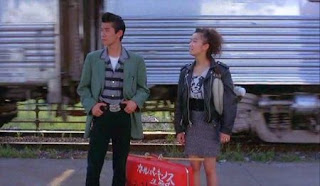Rule of Thirds: Top, Center, Bottom Composition
This shot from Mystery Train is is a great example of the use of the Rule of Thirds to compose the frame in top, center, bottom positon. Two vertically standing characters stand on two imagined vertical dividing lines. The three horizontal dividing lines run through all background and foreground objects at the top, bottom and center of the frame. The emotional/psychological impact of the framing device is the almost comedic spectacle of these foreign characters left on a train platform in an alien world. They are surveying their surroundings with an entirely empty clueless perception of where they are.
Rule of Thirds, Left, Center, Right Composition
This shot from Mystery Train is is a great example of the use of the Rule of Thirds to compose the frame in left, center, right positon. Two seated characters align with the two imagined vertical dividing lines. The three horizontal dividing lines run through all left, center, right objects in the frame. The emotional/psychological impact of the framing device here is the dramatic background spanning in the middle of the modern teenage Japanese couple. They are too busy listening to music and putting on makeup and they have a noticeable lack of reaction to what must be a very unfamiliar landscape. Ultimately they are entirely blind to the cultural differences of themselves and the land they are visiting.
Rule of Thirds, Foreground, Middle Ground, Background Composition
This is a beautiful example from Mystery Train of a composition using the Rule of Thirds, Foreground, Middel Ground and Background with the two imagined veritical lines running along a foreground object on the left and middle ground object on the right. Meanwhile the three imagined horizontal lines fall almost perfectly to devide the foreground, middle ground and background objects. The emotional/psychological impact of the framing device here is the shared visuals of urban decay and juxtaposition of the foreign characters moving through these strange surroundings, looking so lost and out of place.
Eye Room (Lead Room) Composition
This image from Stranger Than Paradise is a great example of the use of Lead Room Composition. The image includes a view of both where the car has been and where the it can travel in the distance. This is a unique example of the compositional tool, as Lead Room predominantly is meant to give the viewer a look at where the moving object will go but here we can see where it has been and where it is going in one frame. The emotional/psychological impact of this tool is the fact that we see where the car is traveling and that is has great distance to travel but the car door is open and the driver in on the room of the car, the only way we know that the car is not actually moving in this image.
Deep Space Composition
This image from Strange Than Paradise is a great example of Deep Space composition. Here two significant elements of the frame are positioned both close and far away from the camera. The emotional/psychological impact of the composition is a clear connection with the character who is clearly a traveler, with her luggage, walking away from a plane and runway in the distance. The audience is forced to wonder where she is going and why she has travled to this place.
Symmetrical Balance Composition
Symmetrical balance is strongly used in this image from Stranger Than Paradise. The two characters are of similar position and size on either side of the frame as they watch television in a dark room. The expressions and relaxed positions of the characters lends an emotional/psychological impact of boredom and darkness with a beautiful shadowy feel brought by light coming from the TV in the foreground.
Compositional Stress Composition
This shot from Dead Man is a great example of the use of Compositional Stress. We see a character holding a gun, obviously a tense and threatening moment but our view of his surroundings is so limited, we are unable to see who he is pointing his weapon at or what or who surrounds our character causing the threat which has lead to his need for the weapon. The stress caused by the lack of knowledge of the source of the threat in this frame is the emotional/psychological impact brought by this compositional tool.







No comments:
Post a Comment